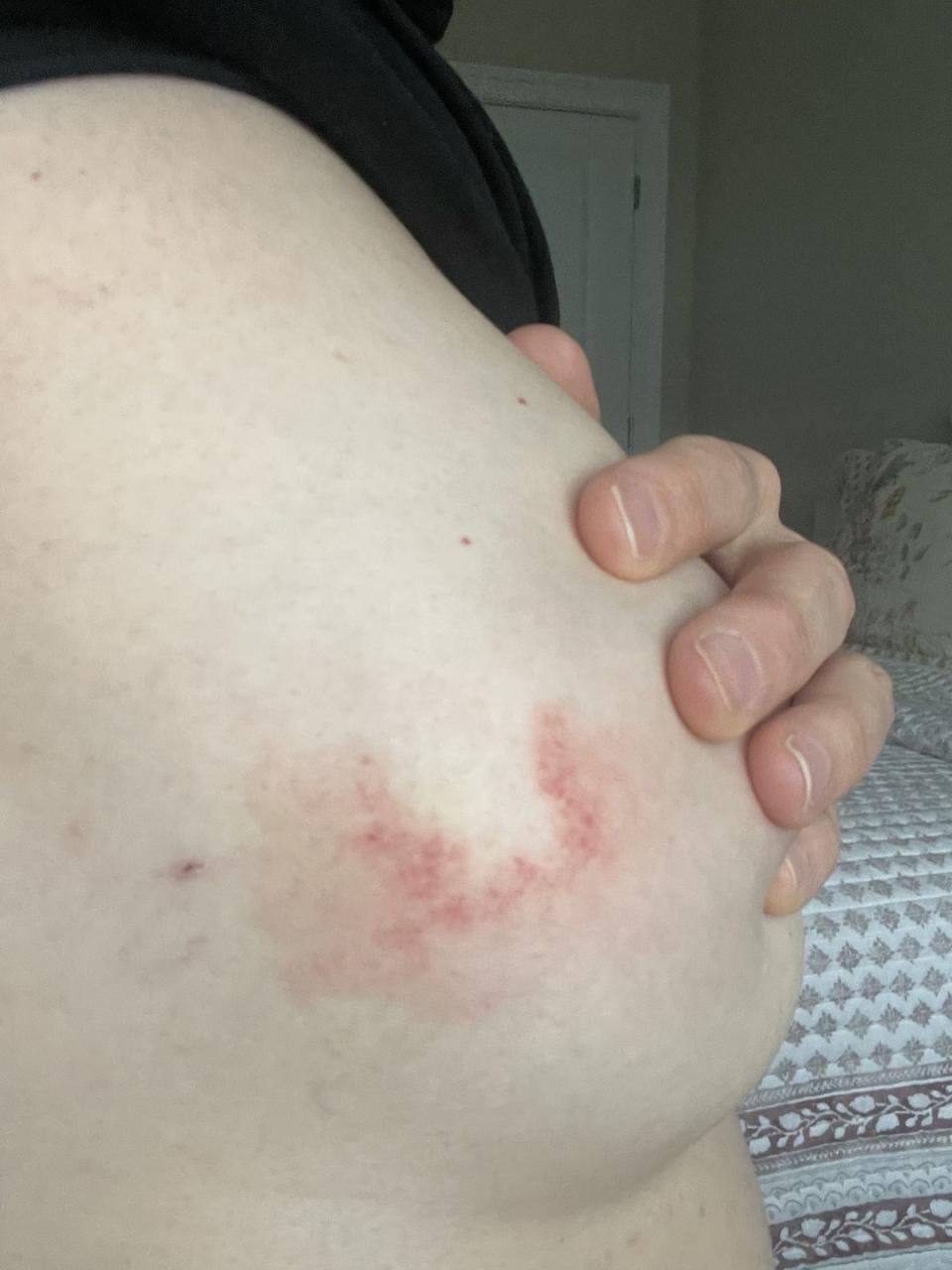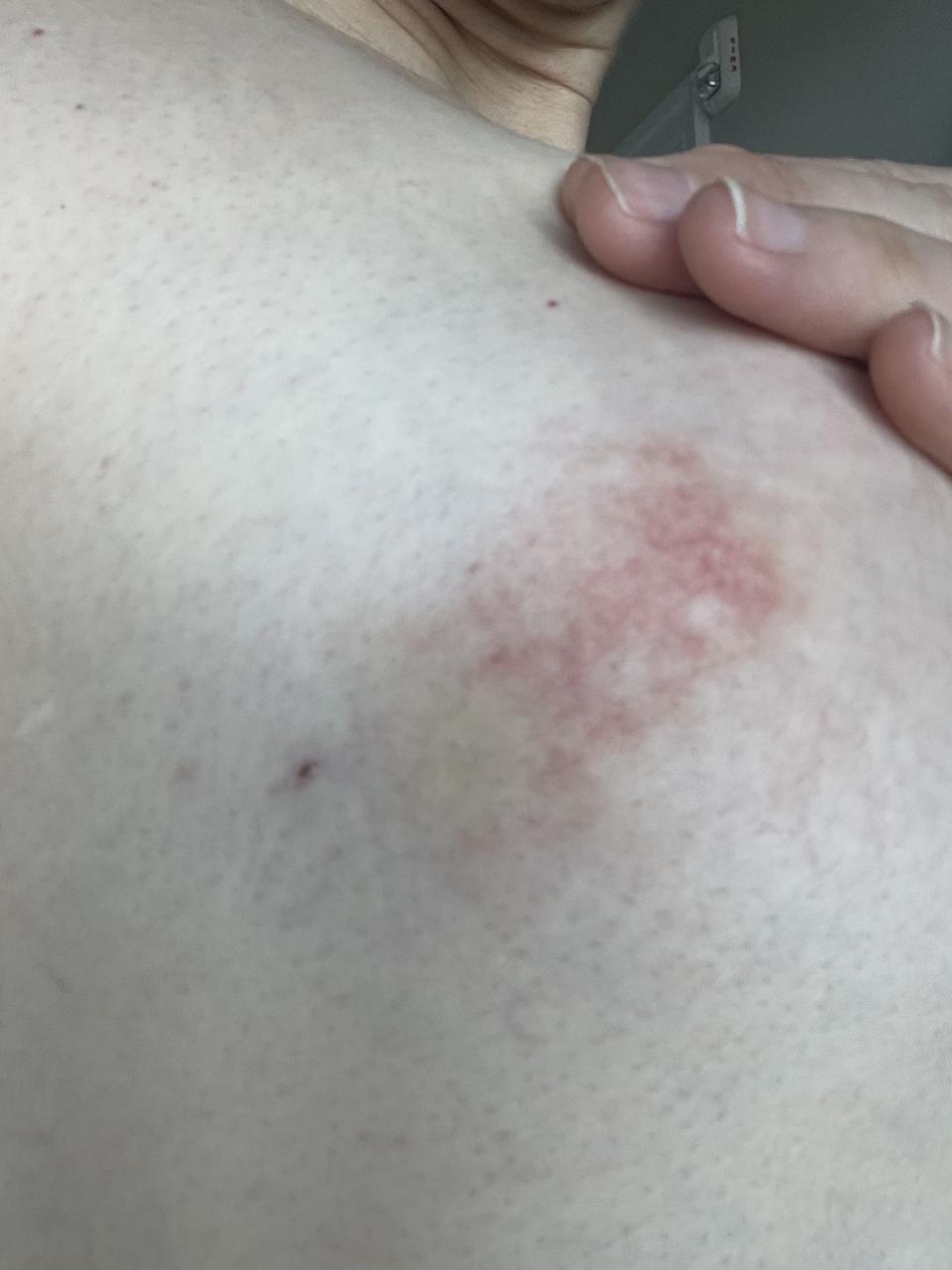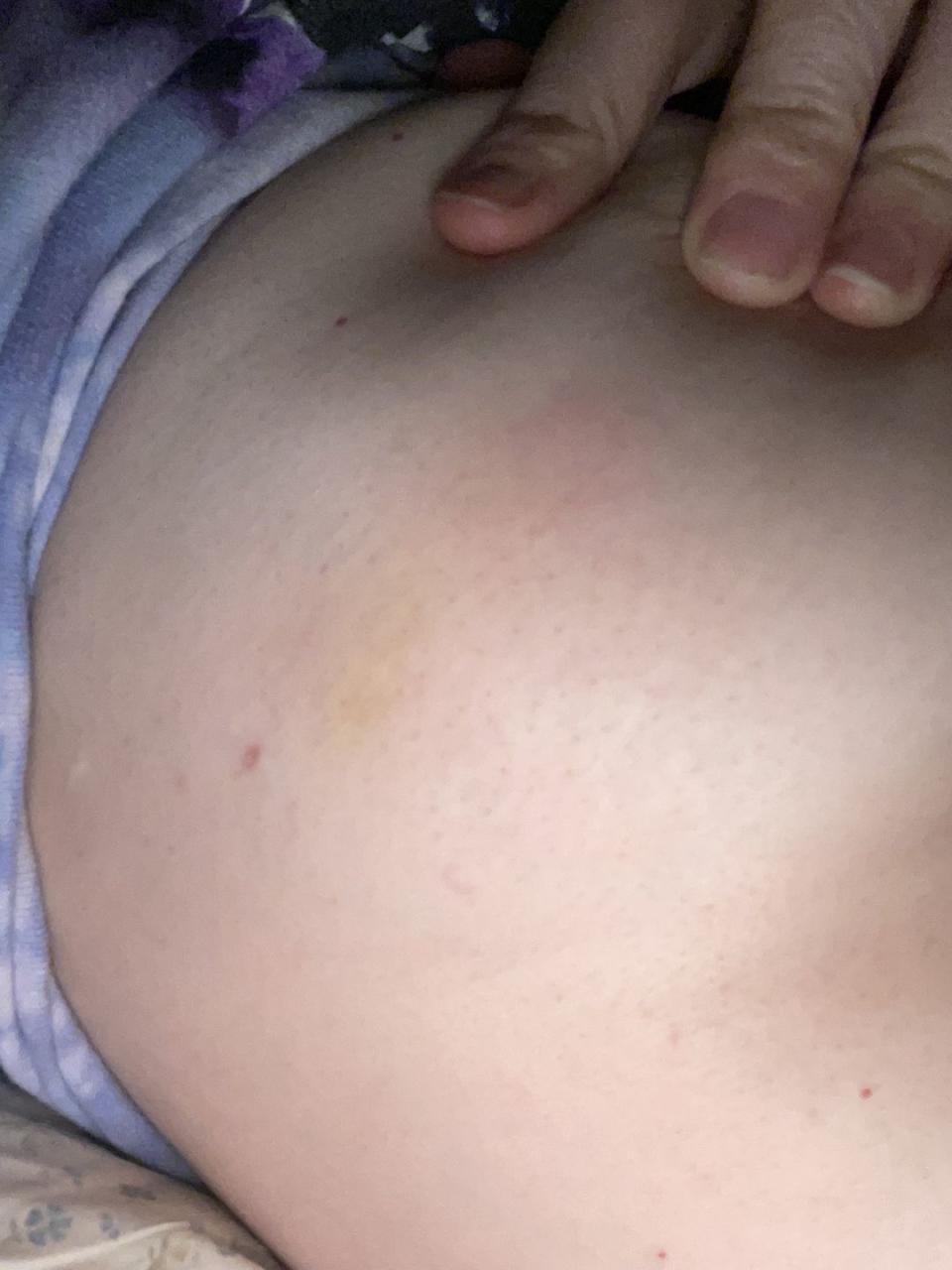'I Needed A Biopsy After My Routine Mammogram. The Biopsy Led To A Rare Allergic Reaction'

My mother died from metastatic breast cancer just shy of her 58th birthday. So I wasn’t surprised when, during a routine mammogram, doctors found something in my left breast that warranted a closer look. I’m a 34-year-old woman whose maternal lineage on both sides has been touched (or whacked) by the disease.
I was surprised when the site of my benign breast biopsy (a procedure in which a sample of breast tissue is removed to be tested for cancer), in February, 2023, turned all sorts of colors and stayed that way long after the procedure. The titanium clip used to mark the spot that’s been tested for cancer—which I was first informed of only moments before my biopsy—did not bode well in my bosom.
Now, there is a good reason these clips are used: Surgical markers help doctors know what areas of breast tissue have been investigated. "If no clip is placed, future breast imagers will not be able to tell exactly what was biopsied, particularly if mammograms are done at new or different locations, and patients may be recommended for repeat biopsies of the same benign site,” explains Laura Dominici, MD, a breast surgical oncologist at Dana-Farber Cancer Institute in Boston.

Still, I had the sneaking suspicion that my body was reacting to that tiny tag.
Historically, I've had issues with copper IUDs. And a quick Google search on these tags led me to research from Urszula Wegner, MD, a radiologist at Kettering General Hospital’s Department of Breast Imaging in the UK, which revealed that, though rare, adverse reactions to metallic markers have been reported.
Unfortunately, this type of reaction is so rare it seems that most doctors don’t often encounter this in their practice. “Due to the rarity of hypersensitivity to titanium or any delayed reaction, such a scenario may not even be considered,” Dr. Wegner tells me. “I am aware of two cases over many years whilst marker insertion is a daily basic procedure.”
I tried to sit tight and trust that perhaps my body was just taking time to heal from the biopsy, which was, after all, surgery—a sentiment and plan of action echoed by my surgeon and the multiple nurse practitioners I was passed along to.
The weeks wore on and, much to my growing alarm, my rash did not subside.
Instead it waxed and waned into a kaleidoscopic pinky flesh that was sometimes accompanied by an inconvenient itch.
Was it my premature return to workouts post-op? My sweaty sports bras flush against my freshly cut flesh? Did I not follow the post-op instructions?
I hated that I even considered what was my body’s way of fighting the foreign to be my fault, as if maybe I had once again failed at being the “good patient” in my loathe and distrust of our medical system.
The surgeon who had placed my tit tag, as I had jokingly come to call it, was reluctant to believe that I was in fact allergic to the titanium clip. She explained that this is the steel used for hip and joint replacements; that few if any experience adverse reactions to it.
“That does not mean it’s impossible, however improbable, for me to have an allergic reaction,” I countered, and pointed out the seemingly obvious notion of outliers. I sensed her resistance to my theory, or perhaps it was just hesitation.
Every three weeks she’d call to see if my breast had healed only to learn the opposite. It was now a game to see what shape my now permanent pink flesh would morph into each day, which is to say it hadn’t gone away. We tried the cortisone, we tried waiting, and we tried trusting my body to adapt.

By month three of my regular check-ins, I knew I'd had enough and decided I wanted the tag out.
I learned from my doctor that removing it shouldn’t have a negative impact on my health, so I was comfortable with my decision to remove it.
“In most simple cases, removal of the unwanted marker from a solitary benign target will not impact health,” says Dr. Wegner. “Vacuum biopsy equipment can vacuum the unwanted marker, but it really depends on the individual case.”
My doctor agreed, and I knew in my bones that my body would not adapt. A part of me was proud of my body’s ability to fight what doesn’t belong and purge itself back to purity.
Let me stress this: A reaction to surgical-grade metal is very rare. Still, it’s worth mentioning that if your skin is sensitive to metal, or you think you may have a metal allergy, talk to your doctor if you’re scheduled for a breast biopsy.
“On several occasions, radiologists or radiographers may choose not to mark the biopsy site, for example if the target is expected to be benign, or if the target is of greater size/easy to identify on modalities regardless,” Dr. Wegner explains. And for women with known sensitivity to nickel or titanium, non-metallic markers can be used. “If a woman is highly allergic to nickel, she should let her doctor know this, as some titanium clips are actually a metal alloy that contain nickel,” says Dr. Dominici. There are pure titanium clips that can be used in these cases.
Currently, I am still working with doctors to get my tag excised as soon as time and money allows.
While there’s been marginal improvement from month one to month six post-op, the irritation remains.

My family history has made my personal future cause for concern, at least when it comes to my breast health. For that reason, I understand why my well-meaning doctors sounded the alarm and strongly encouraged me to start screening regularly for breast cancer. An aggressive proactive approach is key to avoiding a late-stage cancer diagnosis and the pain, cost, and heartbreak of an untimely death like my mother’s, that can come along with it.
I still cannot help but brood in the irony: I went into my very first mammogram with a clean bill of boob health and emerged with an itchy rash.
I’ve learned that by removing and declining the tag moving forward, I will have to work closely with my current doctor who’s familiar with my history or risk a repeat biopsy if I were to establish care elsewhere, since a new doctor may find it difficult to confirm what was sampled. Otherwise, though, it’s not detrimental to my health to not have the tag.
But the frustrating fight to be believed, and fight with insurance to cover the thousands of dollars in medical bills I owed for the biopsy in the first place, was all worth it. This is because at the heart of the matter, my story is about listening to your gut, heart, and in this case…well, ya know.
Trust your body, question doctors, do your own research, and know that the good fight is what makes a good patient.
You Might Also Like


